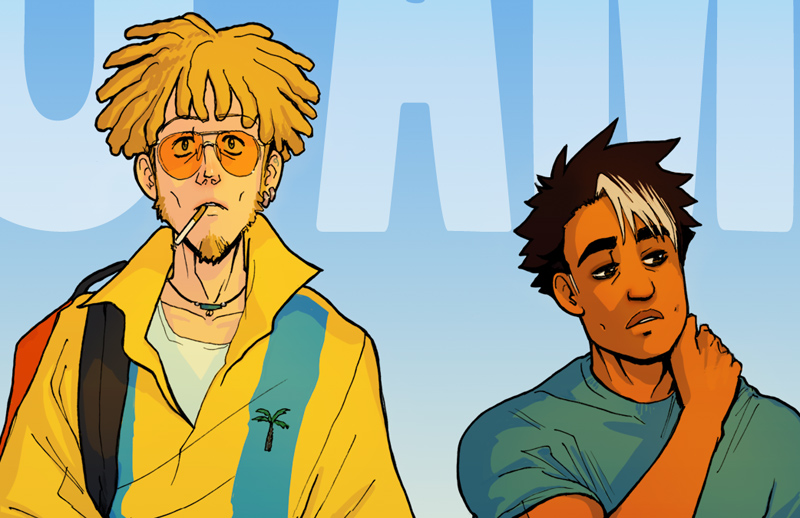There have been almost 6,700 launched comic projects on Kickstarter.
Of those, only half are successful.
And of the successful projects, only 1.5% raise six figures or more.
These campaigns are the vanguard for comics on Kickstarter – often defying expectations and changing how people approach the platform.
While impressive funding totals is part of what makes these campaigns worth studying, it’s not the only interesting aspect.
Most six-figure campaigns don’t set out with massive goals, instead swelling in size over the course of their campaign until they pass that threshold.
What unique advantages do they have that allows them to reach those levels?
And how can the experience that the creators behind these projects gain in running these large campaigns help other creators looking to use the Kickstarter platform as a launchpad for their projects and creative career?
To answer these questions, I’ve been speaking with the creators behind these success stories.
This time, I spoke with Spike Trotman, the creator behind 10 successful comic book kickstarter campaigns.
If you want to check out her latest campaign – you can click here.
So, when I think about indie comics today, I often think of you. In my mind you represent a path for up-and-coming creators to follow – difficult as it may be – and one of the elements that seem central to what you’ve accomplished is Kickstarter.
I’m excited to dig into all of this with you, but I’d love to start back at the beginning and ask you if you remember how you first came across Kickstarter and what you thought of it when you first encountered it?
I was first told about Kickstarter by a friend, onstage, during a panel at a small press convention. I think it was CAKE. His name is Gordon McAlpin, he’s a cartoonist himself. This was the year Kickstarter launched; 2009. He explained it to both me and the audience at the same time, and of course, I am mediately went home and investigated it. I knew right away it was going to be awesome.
It was basically just the formalization of something Internet cartoonists had already been doing for years through PayPal. When we wanted to fund a print run of our books, we took pre-orders and directed people to a PayPal address; they pretty much just had to trust that we were faithfully reporting back on the totals and our costs.
But here was this thing that made everything transparent and trustworthy, and didn’t charge you an arm and a leg to do it. Plus, you can make a nice campaign page, with a video and some images and whatever, and maybe draw in a few new readers instead of just the folks who already knew about you.
There was some resistance at first, of course. There always is. But when even the Luddite hardliners start quietly using the service, you know the debate’s over.
Right, a lot of the perspective on it has definitely shifted. I think following that evolution – back from when you funded your first project, Poorcraft, in 2009 (years before it really took off for comics in 2012 from what I could tell) you probably have a great perspective on it.

While the core of what makes Kickstarter, Kickstarter has remained the same the economy around it has definitely evolved. What do you make of the way the platform has changed and the way it is today?
It’s become a lot more serviceable for folks who use it as a pre-order facilitator. If you ask the guys over at Kickstarter, the ones who started the site, they’ll tell you that they never initially planned for the strong commercial aspect that eventually evolved on the site. You had to do a lot more work behind the scenes in the first few years; calculating shipping, that sort of thing. And when I launched my first project, there wasn’t even a comics category!
They envisioned Kickstarter as almost a privately run endowment facilitator, community theaters funding that year’s season of Shakespeare or dance troupes trying to fund their plane tickets to the semi finals in Tulsa. The “backer rewards” were not envisioned as real products, if you get me? Like, you don’t donate to NPR because your heart is REALLY set on that sweet tote bag.
But, quite frankly, it was just too good an idea and too good a website to stay solely in the hands of artists, ha ha. And I’m very relieved they didn’t try to fight that trend.
They didn’t start Kickstarter with the idea that Spike Lee and Amanda Palmer would show up and make hundreds of thousands of dollars there. But I would argue that was inevitable.
I agree. I think it’s also impressive how they’ve somehow managed to ride the line – between product marketplace & public source of patronage – well over the years.
Though now it’s also changing the industries it’s touching – like music, board games, or comics. As a fan of Kickstarter myself, I wanted to ask about the general role you feel Kickstarter plays in comics today.
For me, when I look back and see the kinds of comics you’ve been able to put out via Kickstarter, from the Adventures of TJ and Amal which just won a Harvey Award, to Smut Peddler, I see books – particularly the latter – that may have had a hard time getting made through traditional channels.
Now, though, as the industry is broadening – with imprints like Oni’s Limerence Press publishing erotic & sex ed comics – do you feel like the role of Kickstarter is changing?
Well, I think the small press has always been the vanguard of comics. It’s where the most interesting subject matter is being tackled, it’s where the most interesting work is being produced. But the small press’ chokepoint has always been two things; funding and audience access. I think Kickstarter has remedied both those problems intentionally and unintentionally, along with the Internet in general.
I would argue that most readers of comics these days don’t actually go into classic comic shops and pick up floppies. Most “comic readers” follow comics online, and develop their tastes outside of the influence of the big two.
The bar for entry in comics is basically down to almost nothing, now. a tumblr page is free. An enterprising teenager can go to the library and scan their artwork, and post it online, and start growing their audience in high school. I’ve seen it happen multiple times. And there’s no editorial staff to hurdle, no old white guy in a suit who’s worried if what you’re doing will sell to other old white guys.
Thank god for that! (edit: or Kickstarter, rather, I suppose)
And if that teenager does their comic for three or four years, gets a big enough audience and enough work finished that a book seems like a good idea, then they can head to Kickstarter and get something printed. They don’t, at any point in the process, actually NEED “the industry” at all.
And meanwhile, the smart ones in the industry are trying to headhunt for talent online, well the stubborn old mules they work alongside with are waiting for this to all pass like a fad. Or, in some cases, wondering aloud why no one wants to work for them, anymore.
I should say here I don’t think Marvel and DC are going anywhere; I think they’re ensconced and comfortable, and they’re reasonably pleased with how things are going. However, they’re also a small part of enormous media conglomerates. They don’t HAVE TO do well, or try new things. Or, quite frankly, even stay solvent.
They’re pretty happy licensing 30 and 50-year-old properties for film and television, which makes sense, because there’s a lot more money in film and television.
I think those facts are what leave places like Kickstarter open for the rest of us, right?
Pretty much!
Comics is so cheap. It’s almost the cheapest thing that a creative person can use to tell a story, short of text alone. So, it can be made without a lot of risk, and with a lot of experimentation, and with no worries about appealing to as many people as possible.

So, stepping away a bit from these “big questions” I want to dive into, specifically, your own experience with Kickstarter projects.
Obviously there’s the Six-Figure projects you’ve done. And will get into the fact that that’s plural in just a second, but even more impressive than that might be that you’ve funded a total of 9 projects, raising more than $660,000. That’s more than half a million.
Before diving into the Six Figure Kickstarters, the Smut Peddler Projects, I want to ask you what you feel has contributed to your enduring success on Kickstarter.
Comics is so cheap. It’s almost the cheapest thing that a creative person can use to tell a story, short of text alone. So, it can be made without a lot of risk, and with a lot of experimentation, and with no worries about appealing to as many people as possible.
Honestly, I’m just making what people want. Fortunately, that seems to match pretty well with what I want.
Or rather the other way around, ha ha.
I made the SP series because I really, REALLY wanted a new smut peddler book out there, and the original publisher didn’t want to take it on. And my other anthologies, like new world and the sleep of reason, those exist because I tend to have a philosophy about the way those sorts of stories are told.
I think our culture in general has a serious issue with imperialist narratives, and those really come to the fore when you read fantasy and sci-fi. New World was my attempt to sort of rethink that way of telling stories. The easiest way I have of explaining it to folks is, will happily watch Indiana Jones break into a temple, round house kick a bunch of brown people off of a suspension bridge, and snatch a golden idol, cheering him all the way, but what if someone showed up at the Vatican tomorrow, slap the Pope off his balcony, and made off with the shroud of Turin?
So New World is an attempt to tell stories from both sides of a culture clash.
And with The Sleep of Reason, I was just tired of horror that was basically “this is how I like to do zombies” or “action adventure time! But with a monster!”
Sleep of Reason was very much inspired by old issues of Taboo, a horror anthology that featured both the first chapters of Alan Moore’s From Hell and what would eventually become Charles Burns’ Black Hole.
If I make a comic, either come up with a theme for an anthology or publish a book by someone else, you can be pretty sure it exists because I feel it has to. And it doesn’t already.
And again, comics are cheap! So I can do that.
I suppose that would help! Haha.
 So, obviously the range of what you’ve been able to bring to life on Kickstarter is impressive. From those comics that you have made possible, though, the Smut Peddler projects were, arguably the most successful – at least in terms of the funding raised.
So, obviously the range of what you’ve been able to bring to life on Kickstarter is impressive. From those comics that you have made possible, though, the Smut Peddler projects were, arguably the most successful – at least in terms of the funding raised.
Both projects – the 2014 edition ($185,301 raised with 5,709 backers) and then the “Smut Peddler Double Header” in 2016 ($161,169 raised with 3,851 backers) – smashed the “Six Figure Milestone” – putting you in the top percentile of successful comic creators on Kickstarter. What do you think distinguished those projects from the other Kickstarters you ran?
Definitely the porn.
Laughs
Ha ha, but it’s more involved than that! The kind of smut that I peddle is smart with a very specific and, as far as the comics community goes, underserved audience in mind.
There’s tons of dirty comics out there. But the vast majority are written solely with a potential heterosexual male audience in mind. And that’s reflected in the panel arrangements, the characters involved, the situations, what the artist and writer think is the most important part of the scene.
Did reaching that level of success with a Kickstarter change your perspective on running campaigns? You’ve had other projects come close before, but I imagine a project that large must come with its own set of challenges.
Ha ha, with the 2012 smut peddler Kickstarter, I remember the point where funding passed $80,000. And a voice in the back of my head said very clearly, “you’re going to die.” Like, this was it, I was gonna screw this up bad. I was doomed. I hadn’t prepared for this level of funding, and I was about to be destroyed. But that didn’t happen! Everything went fine! So honestly, when my $180,000 and $160,000 Kickstarters came around, I wasn’t all that intimidated. I knew the score by then.
It was just a matter of keeping things simple, making sure everybody got what they paid for. And making sure out of everyone the project owed money to, the ARTISTS were PAID FIRST.
That’s a great lesson for other creators on Kickstarter to take away. For those people reading this, who are looking to join the Six-Figure comic club themselves and replicate the kind of success you had, do you have any advice?
The Kickstarter itself will be the easiest part of the Kickstarter. Seriously.
And while I of course understand the attraction of a big fat payout from a project, don’t look at your Kickstarter as a personal pay day, unless your project goal is, literally, “hey everybody, fund my life.” Your project exists to pay for what you claim it’s paying for; nothing more, nothing less.
If there’s some money left over after all is said and done and you get to treat yourself to a new office chair or a new drawing tablet, that’s great. But if that’s the first thing you buy the minute your money hits your account, you’re doing something wrong. Both morally and practically.
And, honestly? I’m glad my first Kickstarter wasn’t some gigantic, six-figure bruiser. I got a chance to work out how these things go without the pressure of 5 or 6000 people waiting for their rewards. Not having a massive first Kickstarter project isn’t something to be disappointed by. Most of us won’t. And that’s probably a good thing.
That’s a fantastic takeaway and note to end on.
I want to thank you for taking the time to chat and share your experiences. If people want to find you online, where can they do that?
You can check out my website at ironcircus.com, and I tweet RELENTLESSLY at @Iron_Spike. I’ve also got an Instagram at ironcircus, and a tumblr at ironcircuscomics.tumblr.com.
Great! Is there anything else you’d like to add?
Hm can’t think of anything. But if you come up with any other questions, I’ll be happy to answer them!
Spike, and what she’s built through Iron Circus Comics, is definitely a creator to look up to. I think the example she’s set through her work on Kickstarter and in the small press world in general is to be admired and learned from.
I hope the lessons she’s shared will help you in your own Kickstarter campaigns.
Her latest Kickstarter campaign, Letters for Lucardo: An Erotic Graphic Novel, is currently on Kickstarter! If you’d like to check out the campaign and support it, you can click here to do so!




